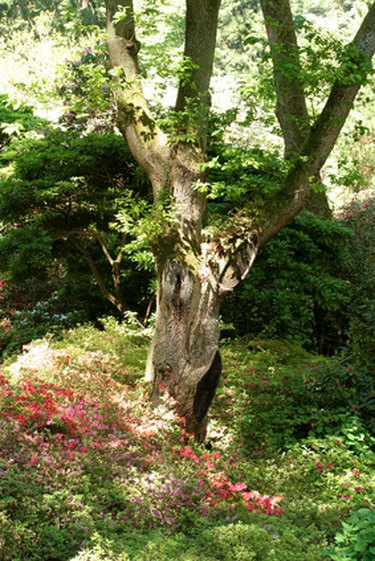
Beloved for their spring or summer flowering displays, gardeners plant azaleas (Rhododendron spp.) in moist, well-drained, acidic soil in any partial-shade to partial-sun exposure. Azalea shrubs tend to develop shallow root systems that don't extend too far from plant trunks. It's important to maintain a healthy soil environment for the long-term health of azaleas as their relatively fibrous and fine root system quickly becomes stressed.
Root Characteristics
Video of the Day
With few exceptions, azalea shrubs develop roots in the top 12 inches of soil. Most of the roots are fine and thin in texture and extend primarily as far as the reach of the branch tips. These fine, feeder roots create a dense and well-defined mass about 12 inches in radius around plant trunks. The American Horticultural Society, in its "A-Z Encyclopedia of Garden Plants," notes that azaleas are surface-rooting and do not tolerate being planted too deeply.
Video of the Day
Azalea Types
While all azaleas are botanically considered rhododendrons, azaleas tend to have thinner and fuzzier leaves and fewer flower stamens than the larger shrubs gardeners refer to as rhododendrons. Within the group called azaleas are shrubs that are evergreen or winter deciduous. The Azalea Society of America notes that some deciduous azalea shrubs may develop slightly deeper and broader spreading roots. However, nearly all types demonstrate the rather shallow, fine-textured root system.
Effects of Soils
The best soil for growing azaleas is a crumbly, porous loam rich in humus, such as decomposed leaves or compost. Azalea roots, being so shallow and small in texture, are more at risk of injury when soil becomes too dry, hot, or flooded with water. Clay soil is too heavy to permit timely drainage away from roots. Submerged roots suffocate and rot since no oxygen remains between soil particles. Sandy soil is too light and fast-draining so roots dry out quickly or heat up fast in sunlight.
Benefits of Mulch
Placing a 2- to 3-inch layer of organic mulch over the root system of azaleas helps keep the roots healthy. The mulch, such as pine bark nuggets, chopped leaves or decaying pine needles, adds acidity to the soil as well as nutrients. In sandy soils or warm areas of a landscape, the mulch helps shade the soil and retain moisture. In clay soils, planting the azalea a 1 to 3 inches above grade with a mound of crumbly soil topped by mulch ensures better drainage as well as shading soil and retaining a moist growing environment. Don't pile mulch too deeply. An overly thick mulch can limit oxygen and rainfall reaching and penetrating into the soil.